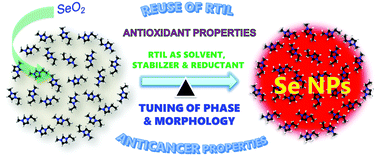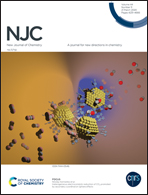A 10 minute approach for the phase specific synthesis of Se nanoparticles with tunable morphology: their anticancer efficacy and the role of an ionic liquid†
Abstract
Meticulous procedures for the targeted synthesis of amorphous Se (α-Se) nanoparticles (NPs) and their rapid phase transformation limit their potential applications in optoelectronics and biomedical fields. Herein, we propose a quick 10 minute highly facile green approach, through which Se NPs of a particular phase as well as morphology can be synthesized in the host matrix of a neat room temperature ionic liquid (RTIL). Various characterization studies involving TEM, SEM, XRD and Raman mapping of NPs were conducted to examine their phase, morphology and stability. An interesting aspect of this methodology is the prolonged stabilization of amorphous Se NPs to months, which otherwise are prone to phase transformation in a few minutes to days, known hitherto. The RTIL used in the synthetic protocol played a 3-in-1 role of a solvent, a reducing agent, and a stabilizing agent. Meanwhile, the antioxidant properties of the Se NPs were also investigated, which revealed significant dependence of the radical scavenging activity on their phase and the morphology. Subsequently, the effect of the phase of the Se NPs on their anti-cancer efficacy was probed. Interestingly, the α-Se NPs outperformed their crystalline counterparts, showing significant cancer cell killing (up to ∼80%), while remaining benign to normal cells. In addition, the RTIL was purified and reused for the synthesis of the next batch of Se NPs.



 Please wait while we load your content...
Please wait while we load your content...